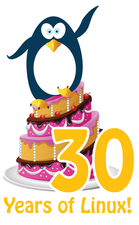This month we celebrate the steady and powerful Linux kernel
Kernel Talk

We celebrate 30 years of Linux with a special issue that takes you inside the kernel and shows you how to take your first steps with the kernel community.
Birthdays are always important, and birthdays that end in zero are especially significant. 30 years of Linux? Seriously? I guess we always knew that Linux was cool, but those of us who were around the water cooler in the early 90s when the first mentions of a new free operating system began to trickle out to Usenet groups never would have guessed that Linux would ever get as big as it is today, running on web servers and washing machines, desktops, cell phones, Mars rovers, and supercomputers around the world.
When we were considering a topic for the 30th birthday of Linux, it soon became clear that the only real way to celebrate was to write about Linux itself – not the agglomeration of software we know as a Linux distro, but the real Linux – the beating heart in the center of it all: the Linux kernel.
When it comes to birthdays, I should add: We ship this magazine all around the world, and it arrives on different shores on different dates over a range of almost two months. So I'm not sure when this issue will actually reach you, but the date we are commemorating is August 25, 1991, when a Finnish college student named Linus Torvalds left a message on the MINIX newsgroup announcing that he was working on a new operating system.
MINIX, which still exists today, is a system created by the famous computer scientist Andrew Tanenbaum that is often used as an educational tool for people to learn about operating systems, so the MINIX community took a special interest in the newly minted Linux. Interestingly, Torvalds and Tanenbaum had a bit of a falling out in those early days over system design: MINIX is a microkernel system, which was thought to be more stable and state of the art, whereas Linux was a monolithic kernel, which looked very retro to the experts. But history has vindicated Linus for this choice: Linux systems now run on most of the biggest and most powerful computers in the world. (In case you are wondering, Linus has since patched up his differences with Tanenbaum, who wrote the book on operating systems that Linus referred to when be built Linux and therefore was something of a mentor.)
This magazine is about diving down deeper into the Linux computing environment, and we continue that mission with this month's cover story. We show you how to tweak the kernel to improve overall performance and response time. We also take you inside the kernel for a close look at how buffer overflow attacks actually work – and why you should install those system updates as soon as you can. We show you how to compile the kernel yourself, and we ask senior kernel manager and Linux Foundation fellow Greg Kroah-Hartman how to get started working with the kernel community.
If you're new to the kernel, or even if you've been around for a while, you'll find something useful in this month's issue. Happy birthday to Linux! Turn the page, and pass the cake.
Buy this article as PDF
(incl. VAT)
Buy Linux Magazine
Subscribe to our Linux Newsletters
Find Linux and Open Source Jobs
Subscribe to our ADMIN Newsletters
Support Our Work
Linux Magazine content is made possible with support from readers like you. Please consider contributing when you’ve found an article to be beneficial.

News
-
TUXEDO Computers Unveils Linux Laptop Featuring AMD Ryzen CPU
This latest release is the first laptop to include the new CPU from Ryzen and Linux preinstalled.
-
XZ Gets the All-Clear
The back door xz vulnerability has been officially reverted for Fedora 40 and versions 38 and 39 were never affected.
-
Canonical Collaborates with Qualcomm on New Venture
This new joint effort is geared toward bringing Ubuntu and Ubuntu Core to Qualcomm-powered devices.
-
Kodi 21.0 Open-Source Entertainment Hub Released
After a year of development, the award-winning Kodi cross-platform, media center software is now available with many new additions and improvements.
-
Linux Usage Increases in Two Key Areas
If market share is your thing, you'll be happy to know that Linux is on the rise in two areas that, if they keep climbing, could have serious meaning for Linux's future.
-
Vulnerability Discovered in xz Libraries
An urgent alert for Fedora 40 has been posted and users should pay attention.
-
Canonical Bumps LTS Support to 12 years
If you're worried that your Ubuntu LTS release won't be supported long enough to last, Canonical has a surprise for you in the form of 12 years of security coverage.
-
Fedora 40 Beta Released Soon
With the official release of Fedora 40 coming in April, it's almost time to download the beta and see what's new.
-
New Pentesting Distribution to Compete with Kali Linux
SnoopGod is now available for your testing needs
-
Juno Computers Launches Another Linux Laptop
If you're looking for a powerhouse laptop that runs Ubuntu, the Juno Computers Neptune 17 v6 should be on your radar.

